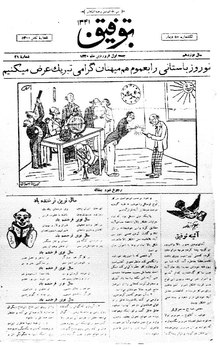Towfigh, also known as Tawfiq, (Persian: توفیق) was a weekly satirical magazine which was published between 1923 and 1971 in Tehran, Iran, with some interruptions. It was among the critics of the Pahlavi rule.[1]
 Cover of the issue 19 | |
| Editor | Hossein Towfigh |
|---|---|
| Categories | Satirical magazine |
| Frequency | Weekly |
| Founder | Hossein Towfigh |
| Founded | 1923 |
| Final issue | 1971 |
| Country | |
| Based in | Tehran |
| Language | Persian |
The journal went through three phases: from 1923 until 1939, under founding editor Hossein Towfigh the magazine was more nationalistic; from 1941 until 1953, under the son Mohammad-Ali Towfigh the magazine was more politically and government-critical; and later versions of the magazine under Towfigh brothers Hassan, Hossein, and Abbas, they focused on pure satire.[2]
History edit
Towfigh was launched in 1923 and was a four-page weekly.[2][3] However, there are other reports giving its foundation date as 1922.[4][5] The headquarters of the magazine was in Tehran.[3] Its founder was the Iranian journalist Hossein Towfigh who edited the magazine until his death in 1939.[3] During his editorship the magazine ceased publication between 1932 and 1938.[3]
He was succeeded by his son Mohammad Ali Towfigh as editor, who restarted the publication in 1941.[3][6] In 1949 the magazine was banned following the frequent publication of the cartoons mocking Prime Minister Abdolhossein Hazhir.[7] Mohammad Ali Towfigh edited Towfigh until 1953 when the magazine was again closed down by the Iranian authorities after the overthrown of the government of Prime Minister Mohammad Mosaddegh.[3][6]
It was restarted on 20 March 1958 with the title Fokāhi (Persian: Humorous).[3] Later it began to be published under its original title and was edited by three nephews of Hossein Towfigh (named Hassan, Hossein and Abbas Towfigh).[2][3] One of its frequent targets was Prime Minister Amir-Abbas Hoveyda[5] who was instrumental in its closure by the censorship agency in 1971.[8]
Content, contributors and political stance edit
Towfigh had a changing political stance throughout its existence. It targeted and expressed the political views of lower- and middle-class Iranians.[4] Its contributors were liberal and secular writers and artists.[4] Major contributors included Abolqasem Halat, Abbas Forat, Iraj Pezeshkzad, Parviz Khatibi, Manouchehr Mahjoubi, Omran Salahi, Manouchehr Ehterami, Kioumars Saberi Foumani, Kambiz Derambakhsh and Naser Pakshir.[6] Hadi Khorsandi started his journalistic career in the magazine which contributed to when he was a high school student.[9]
The magazine featured political caricatures which appeared five years after its start when the Iranian government allowed their publication.[3] These cartoons mostly attacked the members of the Pahlavi dynasty in a covert manner to avoid censorship.[4] From 1938 the magazine began to contain literary material instead of political satire due to the strict censorship exerted by the government.[3] Following the abdication of Reza Shah in 1941 Towfigh continued to publish political cartoons and political satire until its closure in 1971.[3] In these satirical materials the Shah, Mohammad Reza Pahlavi, prime ministers and cabinet members were criticized for their alleged inefficiency and incompetency.[7]
Legacy edit
The Chicago Persian Microfilms Project initiated by the University of Chicago in 1985 archived the issues of Towfigh.[10]
Towfigh cover pages edit
-
Cover page dated 1967 (Salnameh Tawfiq)
-
Cover page dated 21 November 1968 satirizing Prime Minister Hoveyda who is being held by the Towfigh mascot "Kaka Towfigh"
-
Cover page dated 14 January 1968 featuring Iranian Olympic Gold Medalist Gholamreza Takhti after his death telling mourners "don't cry for me, cry for yourselves."
References edit
- ^ گلونی (22 August 2018). "سخنرانی سید فرید قاسمی در بزرگداشت حسن توفیق". golvani.ir (in Persian). Retrieved 6 December 2022.
- ^ a b c Abbas Milani (2008). Eminent Persians: The Men and Women Who Made Modern Iran, 1941-1979, Volumes One and Two. New York, NY: Syracuse University Press. pp. 406–409. ISBN 978-0-8156-0907-0.
- ^ a b c d e f g h i j k Hasan Javadi (2017). "Towfiq (Tawfiq) Newspaper". Encyclopædia Iranica.
- ^ a b c d Sahar Razavi (2021). "Rocks and Hard Places: Gender, Satire, and Social Reproduction in Pre-Revolutionary Iran". Review of Middle East Studies. 55 (1): 72, 84. doi:10.1017/rms.2021.34. S2CID 247980019.
- ^ a b Liora Hendelman-Baavur (2019). Creating the Modern Iranian Woman. Popular Culture between Two Revolutions. Cambridge: Cambridge University Press. p. 74. doi:10.1017/9781108627993. ISBN 9781108627993. S2CID 211433811.
- ^ a b c Mahmud Farjami (2014). "Political Satire as an Index of Press Freedom: A Review of Political Satire in the Iranian Press during the 2000s". Iranian Studies. 47 (2): 219–220. doi:10.1080/00210862.2013.860325. S2CID 145067513.
- ^ a b Babak Rahimi (2015). "Satirical cultures of media publics in Iran". International Communication Gazette. 77 (3): 271. doi:10.1177/1748048514568761. S2CID 144012670.
- ^ Abbas Milani (2004). "Hovayda, Amir-Abbas". Encyclopædia Iranica. Vol. XII.
- ^ Hadi Khorsandi (February 1986). "Sadeq Sedaqat of class 4-D". Index on Censorship. 15 (2): 25–28. doi:10.1080/03064228608534041. S2CID 143127646.
- ^ Laurie Abbott (July 1991). "Report of the Chicago Microfilms Project". Middle East Studies Association Bulletin. 25 (1): 36. doi:10.1017/S0026318400023658. JSTOR 23060983. S2CID 164443556.
External links edit
- Media related to Towfiq at Wikimedia Commons